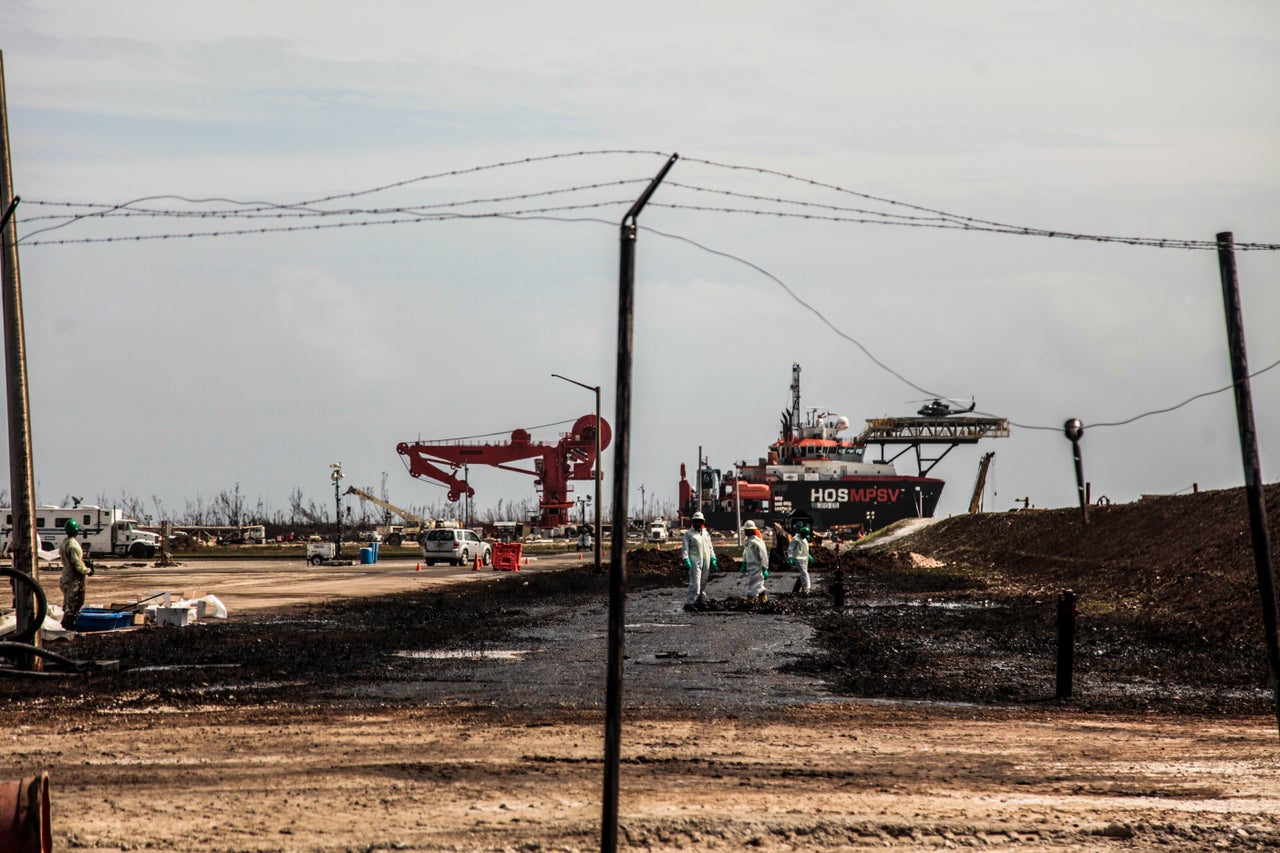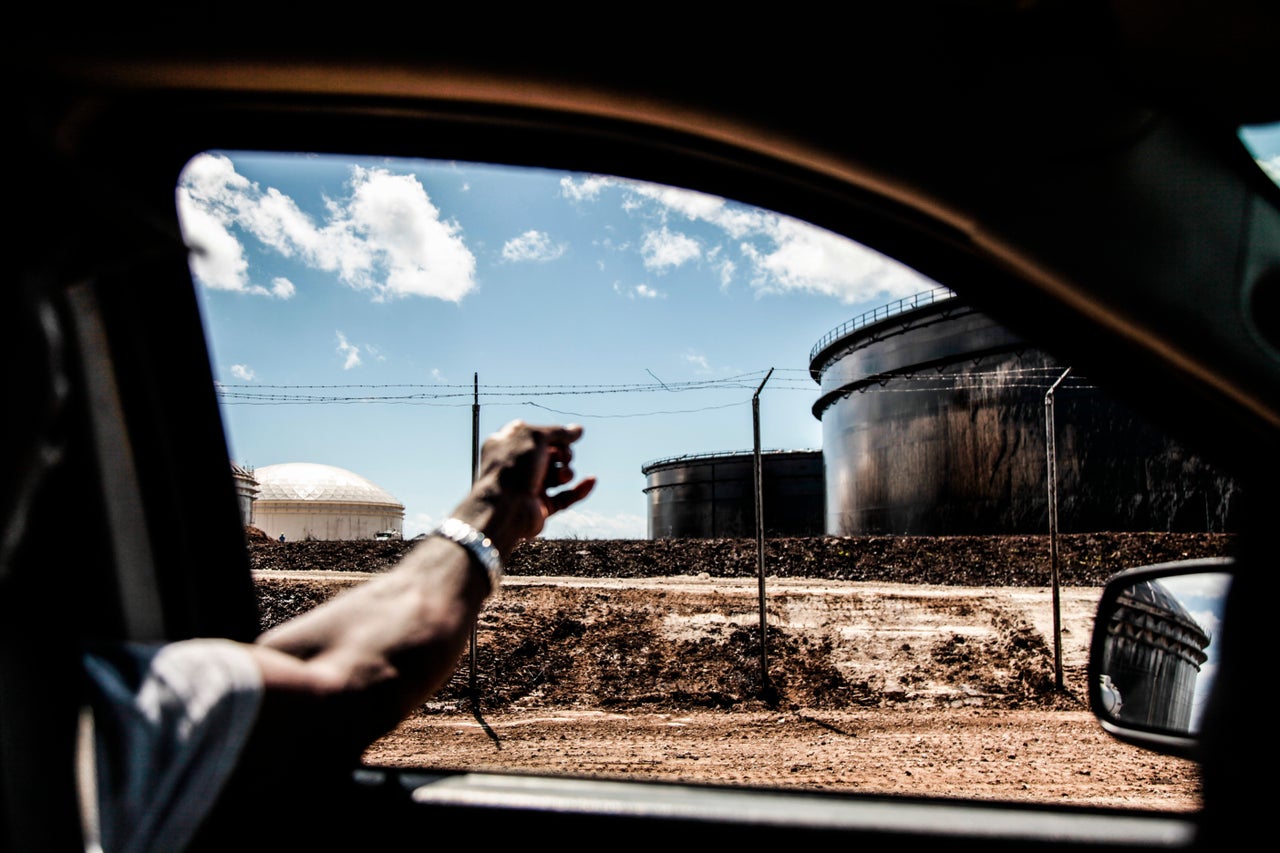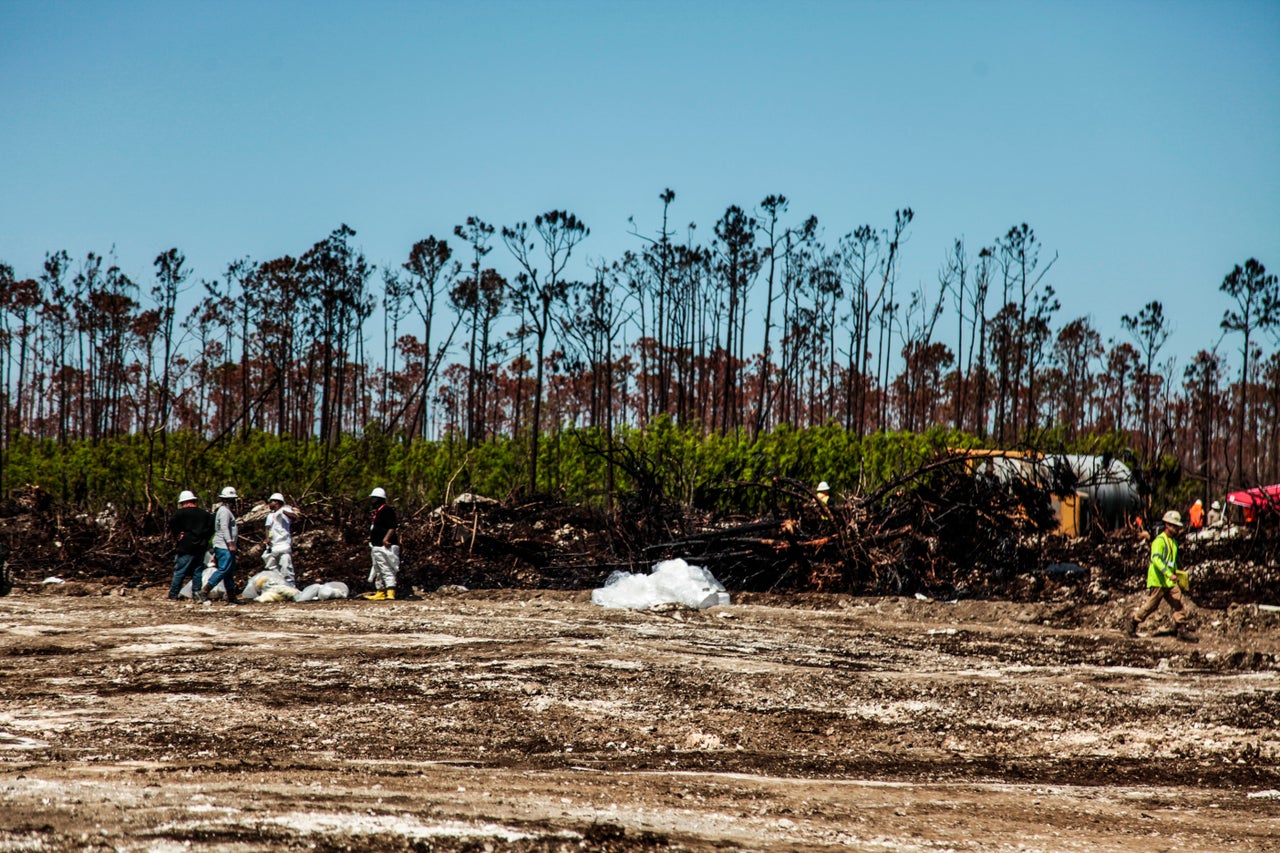SOUTH RIDING POINT, Grand Bahama ― More than three weeks after Hurricane Dorian ravaged the northern Bahamas, the stench of oil was still heavy in the air on this remote stretch of Grand Bahama’s southeast coast. Oil storage tanks at a shipping terminal owned by Norwegian energy giant Equinor sat coated in a layer of crude as if someone had gone at them with an enormous paintbrush.
Dozens of workers, many dressed in plastic hazmat suits, hardhats and boots, were using vacuum trucks and absorbent pads to mop up thousands of barrels of oil that spilled during the Category 5 storm. Other cleanup crews used bulldozers to haul away oil-stained soil and trees. A nearly mile-long swath of forest northeast of the facility remained covered in black sludge.
HuffPost visited the polluted terminal last week and asked to speak with someone about the ongoing response to the hurricane damage. A security guard manning the main entrance said repeatedly that no reporters were allowed on the site.
According to Equinor, 280 people are working to clean up the disaster a month after the storm. Although the company has not said how much oil actually spilled, spokesman Eskil Eriksen told HuffPost in a Wednesday email that crews have recovered more than 22,000 barrels — or 924,000 gallons — of petroleum product at and around the facility. That’s more than three times the 6,000 barrels of oil the company had recovered as of Sept. 24 ― indicating that the spill is much bigger than previously suggested.
The ongoing disaster and cleanup effort serve as yet another reminder of the threat that rapidly worsening climate change poses to coastal fossil fuel infrastructure around the globe, much of which is not built to sustain storms of Dorian’s magnitude.

“Oil industry infrastructure in coastal regions is ill-prepared for a warming world,” said Samantha Joye, a marine science professor at the University of Georgia who has researched the impacts of the 2010 Deepwater Horizon oil spill. “This was clear after Katrina and it is high time that the stability and sturdiness of these facilities be upgraded across the board.”
Much like hurricanes Katrina in 2005 and Harvey in 2017, scientists say Dorian was strengthened by planetary warming. Katrina caused some 8 million gallons of oil to spill from dozens of coastal facilities in Louisiana, while Harvey released nearly 1 million gallons of oil, chemicals and refined fuel from sites across Texas.
A 2015 study from the U.S. Department of Energy concluded that “an extensive amount” of U.S. fossil fuel infrastructure ― including refineries, transport terminals and storage facilities ― is currently at risk of damage from hurricane storm surge and that “climate change is likely to substantially increase the vulnerability of many energy facilities in the coming decades.”
The Bahamas, an island nation of some 400,000 people that sits smack dab in the middle of the Atlantic’s Hurricane Alley, is finding out exactly how vulnerable its own oil facilities are.
Fueled by above-average ocean temperatures, Dorian ― the most powerful hurricane on record in the Bahamas ― made landfall Sept. 1 on the Abaco Islands before stalling over Grand Bahama. For 30 hours, the storm lashed Grand Bahama with Category 5 winds and a storm surge of over 20 feet that flooded 70% of the island, including the international airport.
Equinor’s terminal, located three miles east of the community of High Rock, was designed to withstand Category 5 hurricanes, Eriksen said. Yet Dorian ripped the dome roofs off five storage tanks and spewed nearly a million gallons, at least, onto the ground. The facility’s 10 tanks, nine of which had roofs before the storm, are capable of storing up to 6.75 million barrels of crude oil. A total of 1.8 million barrels was being stored in just three tanks when the hurricane struck.
That has some local residents and environmentalists asking whether Equinor should have done more to prevent or limit the damage from Dorian, including temporarily moving the oil elsewhere or pumping some of the product from the three full tanks into empty ones.

Because the terminal was designed to handle storms of Dorian’s magnitude, Eriksen said the company opted to continue storing oil on the site. “Standard procedures were used to secure all parts of terminal for the forecasted hurricane, including securing all equipment,” he said.
It’s too early to say how exactly the oil spilled, according to Eriksen, but on-the-ground observations of the plume to the northeast of the facility indicate it was primarily transported by the catastrophic winds. He declined to provide an estimate of cleanup costs and said extensive damage has kept the company from safely accessing the tanks to get an accurate measurement of how much oil was lost.
“Our main focus now is to clean up the oil spill, but we will clarify chain of events of the incident and identify measures to prevent similar events to happen again,” he said.
Equinor and the Bahamian government have both come under fire for what many consider a sluggish response to the disaster.
“From what we can see, there appears to be no effort to remediate the situation,” Glenys Hanna-Martin, a member of the Bahamian Parliament and the environmental spokeswoman for the Progressive Liberal Party, said in a Bahamas Press interview outside the damaged oil terminal on Sept. 7. “We know that there is tremendous damage in this area and that the task is huge, but this potentially has serious implications.”
It took more than a week for cleanup crews to arrive on-site and begin containment, a mobilization that Equinor said was challenging due to the extensive infrastructure damage.
Last week, Romauld Ferreira, the country’s environmental minister, swung back against criticism from environmentalists who accused him of not taking the disaster seriously after he’d told reporters that he could confirm “a goat and three birds were impacted by the spill.” Ferreira said that his comment was taken out of context and that authorities are focused on assessing and remediating the damage.
Among the biggest concerns with a spill of this size is that it could contaminate the island’s underground aquifers and leach into the ocean. In a Sept. 11 interview with The Weather Channel, conservation photographer Jim Abernethy reported seeing “oil slicks everywhere” while flying between the islands.
In a press release the same day, Equinor acknowledged that “potential product” had been spotted near Little Abaco Island, some 50 miles northeast of the terminal, but said that it was unable to determine the source. Eriksen told HuffPost that Equinor is conducting ongoing aerial surveys around the Grand Bahama and Abaco islands and has not confirmed the presence of oil at sea. “It is Equinor’s assessment that no oil is currently leaking from the terminal,” he wrote.
But given the height of the storm surge and the facility’s proximity to the shore, it seems highly unlikely that no oil made it into the ocean.
Joseph Darville, an environmental activist with local groups Save the Bays and Waterkeepers Bahamas, has visited the oil terminal seven times over the last few weeks to assess the damage and ongoing response. He met with Equinor officials on Thursday ― one day after he slammed the company for failing to protect the health and safety of Bahamian cleanup crews ― and told HuffPost afterward that he had been assured the energy giant was “treating the matter extremely seriously.”
Equinor officials also told representatives of the two environmental groups that the company did everything it could to protect the facility ahead of Dorian, but that the terminal proved unable to withstand tornadoes spawned by the storm, Darville said.
Waterkeepers Bahamas is conducting water sampling in the area and expects results to be available early next week. Ferreira told reporters that an independent third party is testing ambient air at the site for benzine, an organic compound that is naturally found in crude oil and is a known carcinogen.

While climate change does not cause any single hurricane or other extreme weather event, it has been shown to make them more severe. Scientists have documented a marked slowdown in hurricanes’ speed over both water and land, which increases the risks of heavy rain, flooding and storm surge. Rising sea levels will add to the future damage to coastal infrastructure, including the facilities owned by fossil fuel companies largely responsible for driving the global climate crisis.
In addition to Equinor’s terminal, Grand Bahama is home to Buckeye Bahamas Hub, an 80-tank facility near Freeport that describes itself as the “largest petroleum products terminal in the Western Hemisphere.” That hub suffered only minor wind damage and resumed full operations on Sept. 20, according to a release from Houston-based petroleum distributor Buckeye Partners. No spills have been reported at the site.
Florida-based Oban Energies is pushing ahead with plans to develop the island’s third major oil facility. The proposed $5.5 billion project would be located on the southeast coast near Equinor’s terminal and include storage tanks and an oil refinery. Darville is a fierce opponent of Oban’s project and said the damage that Dorian caused to Equinor’s terminal should be a clear warning.
“[The refinery] should be scrapped in light of the present catastrophic environmental disaster as well as the full speed ahead of climate change and astronomical sea level rise,” he wrote in a WhatsApp message. “It’s a no brainer.”
Following the storm, a consultant for Oban told The Tribune, a Nassau-based newspaper, that the company “remains confident in our environmentally friendly and sustainable development.”
For Greenpeace USA’s Jack Shapiro as well, the Grand Bahama spill illustrates the serious threat facing coastal communities located near fossil fuel infrastructure. And it raises questions about what exactly it means for a facility to be built to withstand a Category 5 storm.
“We’re increasingly being shown that the behavior of these climate-linked extreme weather events is breaking records all the time,” the senior climate campaigner said. “And with that is the evidence that there’s no fossil fuel infrastructure that can truly be considered safe.”
The United Nations warned in a report last year that world governments must cut global emissions roughly in half by 2030 to keep the global mean temperature from reaching 1.5 degrees Celsius (2.7 degrees Fahrenheit) above pre-industrial levels ― the goal of the 2015 Paris climate agreement. At that level of warming, climate-related damages are estimated to cost $54 trillion by the end of the century.
Facing an estimated $7 billion in damages, Abaco and Grand Bahama have a long road to recovery. At least 58 people died and hundreds more are still missing. The nation’s tourism-dependent economy has also taken a major hit.
In a speech at the United Nations in New York last month, Prime Minister Hubert Minnis called Dorian a “physical apocalypse” and said that island nations like the Bahamas “are on the frontlines of being swallowed into an abyss created initially by human activity and increasingly by inaction.”
“We cannot make meaningful progress toward or achieve sustainable development goals if, as forecasters are predicting, the recent cyclonic and other extreme climate events are poised to become the new norm and may worsen,” he said. “When one storm can obliterate an island state or a number of states in one hurricane season, how will we survive? How can we develop? How can we continue to exist?”
